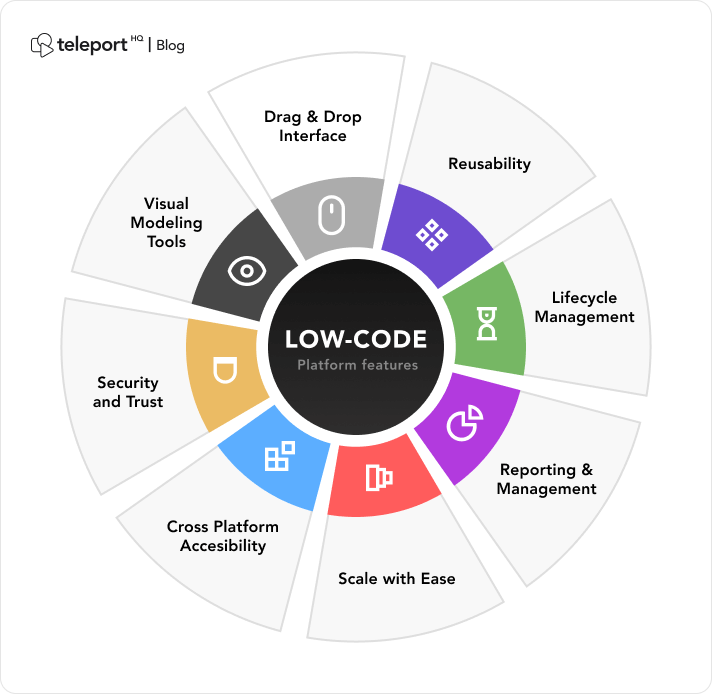New Suggestions For Deciding On Low-code platforms for application development
New Suggestions For Deciding On Low-code platforms for application development
Blog Article
Advantages Of Low-Code Application Development In Terms Of Integration Capabilities
Low-code integration of applications has many advantages, such as the ability to seamlessly integrate with different applications and systems. Here are the major benefits: Pre-built Connectors and APIs:
Many Connectors to Choose From Low-code platforms usually come with a vast library of pre-built connectors for popular enterprise systems (e.g., ERP, CRM databases, cloud services, etc.). The process of integrating the systems can be made easier.
API Integration - Many low-code platforms come with API integration, allowing developers easy access to external services or data sources.
User-friendly:
Drag-and -Drop integration Integration tasks are typically accomplished by using drag and-drop interfaces. Developers and non-developers can set up complex systems that integrate without having to write code.
Visual Workflow Builders: These visual tools are utilized to design workflows, data flow and integrations. They assist in understanding and setting up workflows more easily.
Standardized Integration Methods:
SOAP and Restful Service: Supporting standard web service protocols such as SOAP and REST makes it simple to connect external systems and applications.
OData and various Standards Standardization such as OData permits easy access to and manipulation of data on different platforms and applications.
Real-Time Data Synchronization:
Real-Time Integrations: Low-code systems can handle real-time data sync between applications and systems. This guarantees that information is current and consistent throughout the organization.
Event-Driven Architectures: A few platforms have event-driven architectures which enable applications to react in real-time whenever certain events happen, which is vital for applications that are dynamic.
Legacy System Integration:
Low-code platforms are often utilized to integrate older systems. This allows organizations to upgrade IT infrastructures without the need to completely overhaul the existing systems.
Data Migration Tools: The built-in instruments to migrate data facilitate the transfer of data from older systems to new applications built using low-code platforms.
Third-Party Service Integration:
Cloud Services: Seamless Integration with Cloud Services such as AWS Azure Google Cloud and Google Cloud allows for easy deployment of applications.
Business Applications Integration: Low code platforms can be integrated with various business applications such as Salesforce, SAP and Microsoft Dynamics. This creates a seamless workflow between different business processes.
Simplified data management:
Data models that are unifying: Certain platforms provide low-code support unified data model to make data management easier across platforms.
Data Connectors Pre-configured data connectors allow you to easily access and manipulate data gathered from a variety of sources.
Security and Compliance
Secure Integrations - Low-code platforms are designed to ensure that all integrations adhere to security standards and protocols. This protects the data in transit as well as when it is stored.
Compliance Features: These platforms often include features which assure that integrations are in compliance with the requirements of regulatory agencies, like GDPR or HIPAA. This can provide security for companies handling sensitive data.
Extensibility:
Low-code platforms can often accommodate complex integration requirements by adding custom scripts or code. They provide flexibility, but without sacrificing their accessibility.
Plug-in Ecosystems : An eco system of extensions and plugins allows users to expand the possibilities of integration. They can also add new features when they require.
Overall, integration capabilities within low-code development platforms enable them to be a powerful platform for developing integrated and scalable, efficient and interconnected applications. They allow you to connect disparate platforms. They also enhance the flow of data. Check out the top rated Low-code Platform for application development advice for site recommendations including app modernization, ms azure sql, cross platform mobile app development, application modernization software, database in azure, develop mobile application, no code platforms, rapid applications, ms azure sql, application modernisation and more.
Benefits Of Low-Code Application Development In Terms Of Scalability And Flexibility
Low-code applications offer several advantages when it comes to scaleability. They are scalable and flexible, and they can be adjusted to accommodate new needs. Here are a few key advantages.
Cloud-Based Platforms: A lot of platforms that support low-code use cloud computing. They allow applications to easily scale up and down with the cloud infrastructure. This allows businesses handle increased workload without having to manage servers.
Auto-Scaling Features: Auto-scaling capabilities built into the system will automatically adjust resources in response to the demand, ensuring a consistent performance during peak times without any manual intervention.
Flexible Architecture:
Modular Design: Low-code platforms encourage modularization of applications, which allows components to be independently designed developed, tested and scaleable. This flexibility increases flexibility and makes it easier to upgrade or expand certain elements of an application without affecting the overall system.
Microservices Architecture: Microservices architecture enables the development of applications as a loosely coupled collection of services. This allows for greater the flexibility and scalability.
Customizable Solutions:
Extensibility: Low-code systems typically allow for custom coding and scripting, which allows developers to expand the capabilities of the applications beyond what is available out-of-the-box. This allows unique business requirements to be met with no restrictions.
Third-Party Integrations: Companies can incorporate additional functions and services into their apps by integrating APIs and third-party services.
Agile Development and its deployment
Continuous Delivery and deployment: Low-code platforms work with agile methods and allow continuous integration and delivery (CI/CD). This allows applications to be upgraded and upgraded quickly as a result of user feedback.
Iterative Design: Since low-code is an iterative process, applications can be incrementally improved and then scaled up. This permits controlled growth, and minimizes the risk of large-scale modifications.
Resource Optimization
Effective Resource Management: Low-code platforms allow you to maximize the use of resources by offering tools to monitor and manage the performance of applications. This ensures that resources are used efficiently and are able to be scaled up or down based on the actual requirements.
Load Balancing: The integrated load balancing feature distributes workloads evenly among servers. This enhances the application's capacity to handle the demands of high traffic, and ensures the same performance.
Global Reach
Multi-Region deployment: Low-code platforms are often able to support deployment across multiple regions. This enables businesses to offer low-latency to users around the world. This is essential, especially when it comes to applications that have global users.
Localization Support built-in support for localization lets applications easily be adapted to different languages and regional needs which allows them to adapt to different markets.
Maintenance and updates:
Simplified maintenance: The graphic and module nature of low code applications simplifies the maintenance tasks. They permit updates and bugs fixes to be made quickly without a long period of downtime.
Version Control Systems for Controlling Versions will help you manage the rollbacks, updates and changes. They will make sure that they are released safely and previous version can be restored if needed.
Cost Efficiency:
Low-code platforms reduce development costs by reducing the need for extensive programming. They can also allow you to scale applications with no significant cost or effort.
Pay-As-You Go Models - Many low-code applications have flexible pricing models such as pay-as-you-go, which aligns costs with the actual usage, growth, and financial flexibility.
Low-code development gives businesses numerous advantages, including scalability flexibility, and adaptability. This lets them develop robust, flexible and scalable applications. These platforms enable quick adaptations to changing needs as well as efficient utilization of resources and constant advancement. This ensures that applications are able to grow along with the company. Check out the top rated Legacy application modernization with Low-code for blog tips including cross platform app development, develop cross platform mobile app, no code platforms, develop mobile application, azure sql server, app development platform, jdbc server, rapid applications, sso azure, low code development platforms and more.
Low-Code Applications Offer Benefits In Terms Of Collaboration And Workflow
Low-code application development is a great choice for businesses who want to increase team efficiency by streamlining the development process. These are the primary benefits.
Unified Development Environment (UDE): Low code platforms create a single, unified development environment that allows everyone on the team including developers as well as business analysts, to work together efficiently. They remove silos while encouraging more effective communication.
Visual Development Tool: The drag and drop nature of platforms that use low-code allows team members who are not technical to be involved in the process of development. They will make sure that the business's requirements are precisely analyzed and implemented.
Improved Communication:
Real-Time Co-operation: A lot of platforms with low-code support real-time collaboration features such as commenting, editing in parallel, and receiving immediate feedback. They allow for continuous communication by cutting down on the time needed for back-and-forth discussion.
Shared Workspaces : Teams are able to collaborate within collaborative workspaces. They can access and edit the project components. This ensures that everyone works towards the same purpose.
Streamlined Workflow management:
Project management tools that are built-in Low-code platforms typically come with integrated project management tools that allow teams to plan, track and manage their projects. This includes tasks assignation tracking progress, task assignment, and deadlines management.
Workflow Automation: Automating repetitive tasks and workflows can reduce the manual effort and mistakes, allowing teams to focus on more strategic activities and enhancing overall efficiency.
Faster Iteration:
Rapid Prototyping: Low-code platforms facilitate rapid prototyping. They also facilitate iterative and rapid development. This lets teams create, test and refine applications within shorter time frames. This allows feedback to be quickly integrated and improvements can be made quickly.
Agile Development Support The support for agile methodology lets teams be working in sprints, constantly providing small amounts of functionality. This makes it easier to adapt to the changing needs.
Accessibility for Non-Developers
Citizens Development: Lowcode platforms permit people who use business software (citizen developers), to create as well as modify and maintain applications that do not require a lot of code. This reduces the burden on IT and development teams and allows them to react faster to the needs of business.
Training and Onboarding - Intuitive interfaces, extensive training resources and intuitive interfaces make it easy to help new members to get up to speed and boost the overall team's cooperation.
Centralized documentation, knowledge sharing and dissemination:
Integrated Documentation : Low-code platforms provide a variety of features which allow the creation and maintenance of documents within the platform. This ensures that all information related to the project is accessible and centrally stored.
Knowledge Repositories. Teams are able to create and maintain knowledge repositories, which contain best practices templates as well as a reusable component, facilitating sharing of knowledge and decreasing duplicate effort.
Standardization and Consistency:
Standardized components: A standardized components, built in advance, ensures uniformity in the applications. Team members can comprehend and work more easily with different components.
Governance and Governance and Compliance: Built-in governance structures ensure that every development adheres to regulatory standards and organizational standards and reduce the risk of non-compliance and ensuring that applications adhere to the quality standards.
Feedback and Improvement:
Integrated Feedback Mechanisms: Low-code platforms often provide integrated feedback mechanisms that allow users to provide easy feedback to applications. This can later be integrated into the process of development.
Continuous Improvement: The capacity to quickly test, deploy and change applications based on feedback from users helps them align with the business objectives and user demands.
Visualization and Reporting
Real-Time Analytics: Built-in analytics and reporting tools offer real-time information on the progress of projects, their performance, and user interactions that allow data-driven decision-making.
Visual Workflow Analysis Visual tools are utilized to visualize workflows and processes. These tools help teams analyze and improve their workflows.
In terms of collaboration, low-code apps are an excellent way to simplify workflows, bring different teams together and automate tasks. This creates more effective and agile development environment that is co-operative.